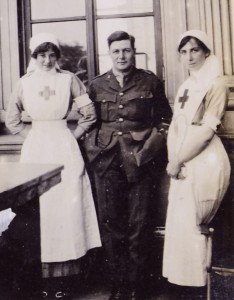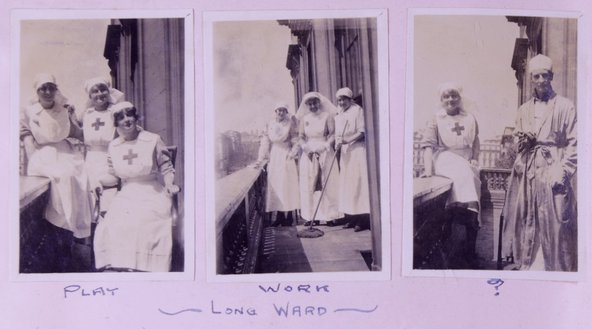10 Carlton House Terrace – from Home to Hospital
by Karen Syrett
3 Dec 2014
The British Academy moved to 10 Carlton House Terrace in 1998 but for the first 90 years of its life the house was the London home of the Ridley family – a wealthy coal mining family based in Northumberland. When war broke out in 1914, Lady Ridley decided to open up her London home as a Hospital for Officers. She started with just 25 beds in the ballroom and drawing room but, as the war progressed, Lady Ridley made more room available by moving out a lot of her furniture and pictures and opening up further wards on the ground and first floor. By 1917 there were 60 beds, and huts had been built on the terrace to cater for soldiers suffering from poison gas.
The Hospital was staffed by a resident doctor and volunteer nurses (VADs) who worked alongside qualified nurses. One of the VADs was Aileen Maunsell. Aileen was 19 when the First World War broke out and, like many girls her age, she quickly volunteered to attend home nursing courses and become a nurse.
Aileen’s grandson, Hugo Gell, recently brought his grandmother’s scrapbook and diaries along to the Academy for me to have a look at. They provide a wonderful insight into the life of the hospital. This is how she describes her first day as a nurse:
Thursday 3 June 1915 – Off at 8.30 by taxie to nurse at Lady Ridly’s Hospital 10 Carlton House Terrace. Put in Long Ward with Sister Bell & Nurse Paice 8 patients. 3 bad stretcher cases & 1 bad arms. Off from 2 to 4, got Red X uniform at Harrods. Dead beat by 8.30.

Aileen’s work at the hospital was varied to say the least. She took the dressings to be sterilized at St Thomas’s Hospital, she bathed and fed the patients and took their temperature, she cleaned the wards and made the beds. She learnt how to ‘work electricity’on patients and how to deal with haemorrhages.
In January 1916, she even records the outbreak of a manicuring craze which lasted for several days: ‘Busy morning – manicured folk’. Aileen also spent a lot of her time chatting and laughing with the patients and was no doubt involved in concocting many of the nicknames given to the nurses and soldiers; hers was Dinkie. The young convalescing officers were often bored and therefore boisterous but it is clear from her diaries that Dinkie was more than capable of giving as good as she got:
Thursday 11 October 1917 – Great rag in evening, pillow fights…sponges, cushions, pillows & paper flying. I upset all Mr Walton’s water by mistake unfortunately – Sis[ter] Jones furious. All blew over though in the end.
When Aileen slipped coming down the black marble staircase a few days later, she sprained her ankle and had to go home for a few days. The event was recorded in a poem by one of her patients:
Last week our Dinkie fell down stairs…
The North Ward all dissolved in tears
When they heard the news.
Young Duncan was disconsolate
And Barry got the blues.
Life is weary, life is sad
What shall we do without her
It’s only ‘cos I feel so bad
I write this song about her.

The soldiers’ injuries were horrific and the work was hard but there was also a great deal of merriment at the hospital, and romance. Aileen received at least two proposals of marriage from her patients before finally accepting Mr Gell. Philip Gell was admitted to the hospital towards the end of the war and the couple married in 1920.
It has been a real privilege to read Aileen’s diaries. Now, as I wander around the building, I can’t help but imagine all the soldiers and nurses who spent such an intense time in these rooms, and I always take extra special care whenever I come down those black marble stairs!
Karen Syrett is the Archivist/Librarian at the British Academy.
(A longer article on this subject has been published in the British Academy Review – PDF file.)


